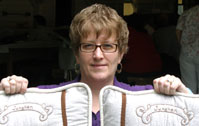
|
2009 Annual Review |
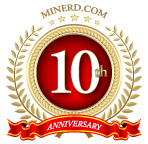 |
If you have ever googled your own name, or a relative's maiden name, you are the very reason why Minerd.com was created in 2000. My precise intention was to attract online searchers among an estimated tens of thousands of cousins of the sprawling Minerd-Minard-Miner-Minor family.
 |
Minerd.com homepage |
Now, a decade later, the site continues to pursue its mission, having drawn nearly 1,000 distant relatives and friends out of the woodwork. Each has added a unique thread to the fabric of documented lives and stories of our Pennsylvania-German pioneer clan. But with an estimated 50,000 of us "out there," the site has a long way to go before connecting with everyone and telling a truly complete story.
Of its 10 years online, the past one has been an extraordinary year of growth and public recognition. For the second time, Family Tree Magazine named it one of the top 10 family websites in the nation. Cousins have provided valuable content and insights.
And thanks to extraordinary online tools such as Ancestry.com, American Memory Project, Google Books and Google Scholar, many previously opaque windows of discovery are now wide open. Recognizing the site's value, prominent institutions such as Walgreens, National Mining Hall of Fame, University of Virginia and American Advertising Federation graciously furnished rare photographs. And with the economy appearing to be rebounding, the number of monthly visits to the site, down the past two years, seems once again to be on the rise.
|
~ Ten Years of Visits and Most Popular Pages ~ |
|
|
|
Minerd.com received 180,336 visits in 2009 -- the fourth highest total in the decade. Will 2010 numbers go up as the economy improves? |
|
Most Popular Pages and Biographies in 2009: |
|
Top Features: |
Top Biographies: |
New or Expanded Feature and Analysis Pages in 2009: |
Meaningful Growth Statistics: |
|
New Bios Added in 2009: 76 |
New Images Added in 2009: 1,140 |
|
Total Bios At End of 2009: 1,332 |
Total Images At End of 2009: 7,770 |
|
Bios at May 2000 Launch: 250 |
Images At May 2000 Launch: 1,400 + |
|
Great-Grandchildren of the Pioneer Minerds Discovered in 2009: 1 |
Gr-Gr Grandchildren of the Pioneer Minerds Discovered in 2009: 56 |
|
Total Lives Tracked, First Four Generations of Offspring of the Pioneer Minerds: 1,957, including 12 children - 87 grandchildren - 470 known great-grandchildren - 1,400 known great- great- grandchildren |
|
Photo of the Month Recap - Jan.-Dec. 2009 |
|
~ Top New or Expanded Discoveries in 2009 ~ |
|
The more we dig, the more we learn, and the more we question. That cycle leads to the inevitable conclusion that the family at large has played a broader, more fascinating role in the sweep of Americana than I could have ever imagined. Top finds of 2009 include the following personalities and stories: |
|
|
|
|
|
|
|
Leona Thorne - educator for the Chicago Board of Education spanning more than half of a century, teaching circa 1880 at Cottage Grove School and later at J.R. Doolittle, Jr. School (1892-1894), Ryder School (1911) and then as principal at Moseley School (1915-1922). |
|
|
|
Ernest Uriah Ayars - devoted his life to a career as a Seventh-Day Adventist Church missionary and educator in South America, helping found or lead schools such as the Chile Academy in Chillán, Chile; Lima, Peru; and River Plate College in Argentina. Mentioned in many articles in the national Review & Herald newspaper. |
|
|
|
|
|
|
|
|
|
|
|
|
|
|
|
Civil War Cousin Headcount Increases to 106 |
|
Under the Freedom of Information Act, the U.S. Veterans Administration provided copies of previously thought-to-be-lost Civil War pension files of Gilman Rose and Eugenus B. King, adding deeply to our body of knowledge about these men and their immediate families during and after the war. |
~ Research Trip to Kansas City Region~
 |
Eugene Podraza at the Clark grave, Laredo |
A great differentiating strengths of Minerd.com is its relentless pursuit of original, on-site, proprietary research on a national scale. In August-September 2009, for the 18th year, cousin Eugene Podraza and I traveled to a new region to conduct our work -- this time to 13 counties in five days in Kansas City, Northwest Missouri and Eastern Kansas.
The red dots on the map at left show the counties where we conducted our proprietary brand of "paper archaeology."
We focused on gathering firsthand documentation about 19th century cousins who migrated to Northwest Missouri, never to return, and long forgotten by kin back East.
The research involved time-tested procedures of visiting courthouses and libraries to obtain public records (wills, deeds and newspaper obituaries) and exploring cemeteries to find and photograph ancient, fading or overgrown grave markers.
The trip produced more than 175 pages of copied archival material and the acquisition of several books -- now added to the family archive of some 125,000 pages -- and scores of photographs of many old family grave markers and farms. Seen here, cousin Eugene pays his respect at the neglected, rural grave of George "William" and Helen (White) Clark at the Joab Holloway Cemetery near Laredo, Grundy County.
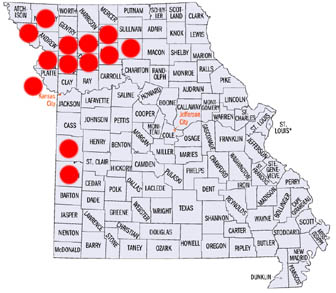 |
Red dots mark the sites we visited in northwest Missouri |
Since 1990, Eugene and I have visited nearly 60 counties in Illinois, Indiana, Ohio, West Virginia, Maryland, Pennsylvania and District of Columbia. They assure that data come from the best possible original sources, rather than relying on the work of others. During 2009, I also personally traveled to these exceptional repositories -- the Allen County Public Library in Fort Wayne, IN; National Archives in Washington, DC; and West Virginia University in Morgantown, WV.
"Share This" icon |
~ Reaching Younger Audiences in Today's Fast-Paced Society ~
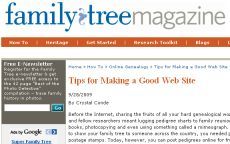 |
Family Tree again cites Minerd.com as a top 10 personal family website |
Younger Americans today are hungry for historical understanding, to figure their place and context in the chaos of today's society, but do not know how to make this connection. Minerd.com strives for relevance, not only by being search-engine friendly, but also by utilizing social media technology in the hope the website's story will spread to a technologically savvy group.
This has included adding the "Share This" icon at the top of each page, to be shared with others via email, Facebook and Twitter, among others. I also am using my personal Facebook page to promote the website and reunion.
In its article "Tips for Making a Good Web Site," the Sept. 28, 2009 edition of Family Tree Magazine again ranks Minerd.com among the nation's "10 personal genealogy Web sites" that "are the cream of the crop." Says the magazine, "Take some time to visit them. They might inspire you to clean up your existing family history site, or to put your own fascinating family story online." Full text.
In March 2009, Diane Haddad of Family Tree Magazine wrote a remarkable post on her Genealogy Insider blog, entitled "Tips from a Reunion Whiz." She analyzed our "Pittsburgh 250" family reunion as an example to follow. Diane identified four highlights for readers to "steal some inspiration for your own gatherings." Her suggestions included: 1.) Enlarge your invite list; 2.) Consider sponsorship; 3.) Visit a historical site; and 4.) Incorporate family history. Full text link.
|
|
| March 2009 blog posting by Genealogy Insider's Diane Haddad, analyzing last year's "Pittsburgh 250" reunion, entitled "Tips from a Family Reunion Whiz." Full text. |
Requested Minerd.com content |
Toward the end of 2009, VisitPittsburgh.com (the former Greater Pittsburgh Convention and Visitors Bureau) requested Minerd.com content for its 2010 Visitors Guide, to be sent to all potential visitors who inquire about Pittsburgh as a destination. During the year, I also fielded inquiries from non-cousin researchers and authors seeking material about the Civil War, National Road and composer Franz Liszt.
 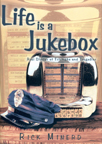 |
Two books naming Minerd.com |
Reflecting Minerd.com's relevance beyond our family, the site and/or I were mentioned in two books the past year -- Dunbar: Images of America, by the Dunbar (PA) Historical Society; and Life Is a Jukebox: Real Stories of Triumphs and Tragedies, authored by Richard Dean "Rick" Minerd and produced by Trafford Publishing. Minerd.com also was featured in articles and blog postings by Family Tree Magazine.
In November, I was honored to present my powerpoint talk on "Tontogany's Deep Secret: The Unknown Son of Capt. Thomas Ward Custer," to the Civil War Round Table, North East Ohio Chapter, near Cleveland.
To more proactively pushing Minerd.com's story to our cousins and the public, I am emailing the "Photo of the Month" every month to a large number of cousins as well as to leading museums, research libraries, news journalists and economic development officials who might enjoy this unique feature. If you would like to be added to (or removed from) this list, contact me.
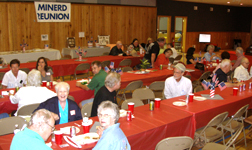 |
Minerd Reunion group |
~
Next Minerd Reunion to Be Held in 2011,
Moving to An Every-Other-Year Format;
Younkin/Junghen Reunion Has New Leadership ~
Minerd-Minard-Miner-Minor - Following our blowout "Pittsburgh 250" reunion in 2008, followed by a smaller turnout for the 2009 event, your reunion committee decided to make a change. Henceforth we will gather every other year rather than annually. Thus we will not have a reunion in 2010, but will re-convene again in June or July 2011 at the Indian Creek Valley Community Center near Pittsburgh.
Re-inventing the reunion a bit will help us appeal more to younger families with children. While this could include more emphasis on children's games, spouse entertainment (golf) and VIP speakers, we need the help of good volunteers. We have to think creatively and unusually to keep appealing to the broad masses of cousins. Will you consider helping? If so, please contact me.
|
|
| Newly elected Younkin/Junghen reunion president Toni (Guth) Younkin, left, completes the 1930s legacy of her husband's grandfather Charles A. Younkin and the 1990s legacy of the late Donna (Younkin) Logan, right. |
 |
Charles A. Younkin |
Younkin/Junghen Reunion in Western PA - Some of you know that I help plan the annual Younkin/Junghen Reunions, held at the Odd Fellows Picnic Grove each July in Somerset County, PA. At the 2009 Younkin gathering, Toni (Guth) Younkin, wife of Charles E. "Chuck" Younkin, was elected president. With this election, Toni fulfills a legacy begun in 1934 when Chuck's grandfather, Charles Arthur Younkin (nicknamed "Charleroi Charley"),co-founded the original National Younkin Home-Coming Reunion.
Charleroi Charley also was publisher of the family's remarkable national newspaper, the Younkin Family News Bulletin, produced and distributed from 1937 to 1941. There have been many inter-marriages between the Minerd and Younkin "kissin' cousins," and Minerd.com is pleased to host this family's reunion archives and to help publicize the annual reunion. In 2008, I helped re-publish a booklet reprinting of all eight issues of the remarkable family newspapers totaling some 44 pages of unique material, many of which were donated to local libraries and historical societies.
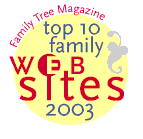 |
~ A Look Back at Minerd.com's Creation ~
When Minerd.com was launched on May 7, 2000, it targeted two strategic audiences -- cousins who already came to our annual reunion in Southwestern Pennsylvania -- and the tens of thousands of others who had to be "out there" but knew nothing of the connection. My guiding belief in building Minerd.com was to use search engines (remember Dogpile and Altavista?) to reach curious cousins. Thus the site needed to be loaded with specific names, hometowns, photographs and stories to attract search spiders, lead web surfers to find their family connection, and keep them engaged. To quote Amazon.com founder Jeff Bezos, Minerd.com needed to "get big fast."
Fueled by several early awards and positive local and national press coverage, the site began to be recognized beyond our family for its emphasis on what families can become over longer periods of time. Our culture does not think in these terms and has no easy words to describe the concept.
In short, Minerd.com became an ever-expanding, encyclopedic, free online museum of 1,332 biographies (of cousins virtually all born before 1900) and a visual feast of 7,770 images. It tells the story of the eight to 10 generations of offspring of Revolutionary War veteran Jacob Minerd Sr. and his wife Maria (Nein), who settled on the mountainous border of Fayette and Somerset Counties in 1791.
Little could these original Minerds have known that their 12 children would produce 87 children, 470 grandchildren and 1,400 great-grandchildren, for a total of at least 1,957 lives created by the year 1900. They never could have envisioned that by 2010, the size of their brood -- fueled by the "time value" of population growth and the Baby Boom generation -- would swell to tens of thousands of lives, scattered all around the globe. Instead of tracing backward in time, Minerd.com is forward-looking, with its focus moving from past generations ever closer to the present day. Pittsburgh Quarterly Magazine said that the site "has connected thousands of ... relatives to historic family information via its online archive."
Minerd.com may well be unique in today's society for its purpose, scope and magnitude. I do not know of any other website quite like it.
 |
Scanning Civil War diaries |
~ A Look Ahead - Publishing Civil War Diaries ~
One of the most rewarding afternoons of 2009 was spent with my scanner and laptop in a cousin's home in Somerset County, PA. That day, we completed the high resolution copying of Civil War diaries of her great-great grandfather, a private in the 142nd Pennsylvania Volunteer Infantry. I have been asked to help publishing these diaries for the benefit of our family and Civil War enthusiasts. That's me in this photo, holding the scanner lid with one hand and typing on my laptop with the other.
~ Fixing and Fine-Tuning ~
To make it easier to find specific information on the site, I added a custom search engine powered by Google.com. It's on the home page and Biographies page. To eliminate a small annoyance, and to make Minerd.com as appealing as possible to search engine spiders, I eliminated several hundred broken links. Many of these formerly led to third-party websites that are no longer online or where their URLs (addresses) had changed.. If for some reason I deleted a link to your website, and you would like it to be restored, contact me.
~ In Closing, A Heart-felt Thank You! ~
Ten years after it began, I wish to acknowledge my appreciation for and once again thank my original technical/legal advisory team: the late Douglas Arthur Nicklow, Aimee McCabe-Walker; Jacque Rowden and lawyer George Patrick Baier.
This work continues to be deeply fulfilling as well as eye-opening. Thank you again to everyone who has contributed your part. This site is for you, and would not be possible without you.
Sincerely,
Mark A. Miner
Founder, Minerd.com
January 2010
All Minerd.com Annual Reviews: 2018 - 2017 - 2016 - 2015 - 2014 - 2013 - 2012 - 2011 - 2010 - 2009 |
Copyright © Mark A. Miner |

















 In 2009, five cousins were newly discovered
to have been Civil War soldiers, bringing the headcount of known cousins and
spouses serving in the "War of Rebellion" to 106. These four fought for the Union:
In 2009, five cousins were newly discovered
to have been Civil War soldiers, bringing the headcount of known cousins and
spouses serving in the "War of Rebellion" to 106. These four fought for the Union: 


